Navigating the Used Kiteboarding Gear Market
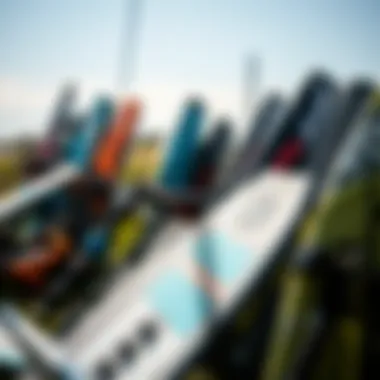
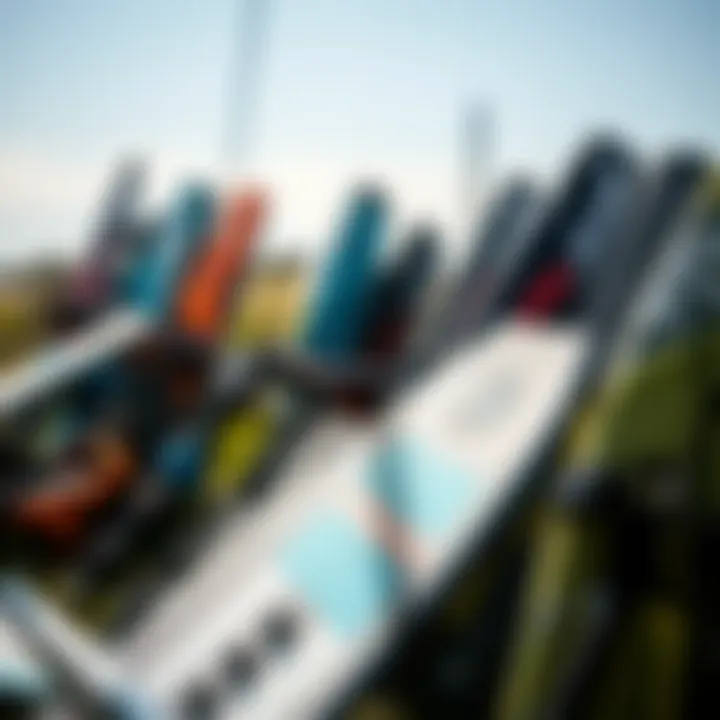
Intro
The kiteboarding scene is one that thrives on connection—between the wind, water, and board. As kiteboarding continues to capture the hearts of both veterans and newcomers, an emerging trend can no longer be brushed aside: the market for used gear. Whether you're a seasoned pro or just dipping your toes into the sport, purchasing second-hand equipment presents unique advantages that go beyond just saving a few bucks. This article intends to cast a spotlight on the growing interest in pre-owned kiteboarding gear, highlighting not only the benefits but also the considerations that come with venturing into the world of used equipment.
Buying used gear can be a double-edged sword. With every positive, there comes a flip side that one must navigate carefully. But fear not; we’ll unpack these complexities in detail.
Today’s article will touch upon essential topics like the importance of sustainability, practical tips for assessing gear quality, and a glance at various marketplace platforms. We’ll also take a moment to unpack equipment maintenance, ensuring your second-hand purchase remains in tip-top shape.
As this discussion unfolds, keep in mind that becoming knowledgeable about used gear not only enriches your own kiteboarding experience but also aids the environment by promoting reuse and sustainability. So let’s jump right in and explore the fascinating market for used kiteboarding gear.
Understanding the Appeal of Used Kiteboarding Gear
In the world of kiteboarding, finding quality gear doesn't have to break the bank. The appeal of used kiteboarding equipment has surged in recent years. Kiteboarders, whether seasoned veterans or eager newbies, have started to see the value in second-hand options. This section delves into what makes used kiteboarding gear so attractive, spotlighting three key elements: economic advantages, sustainability considerations, and the variety that comes with purchasing pre-owned equipment.
Economic Advantages
Diving into the financial aspect, buying used kiteboarding gear has a clear edge over splurging on brand new items. For many riders, especially those just starting out, the cost of new equipment can be as shocking as a rogue wave. When pre-owned gear is involved, it's possible to snag high-quality items at a fraction of the original price.
- Affordability: Whether it's a kite, board, or harness, there's a tangible cost saving in choosing used products. Riders can often find items that have been gently used, meaning they still have plenty of life left without the steep price tag.
- Better Quality for Less: Often, purchasing used gear allows budget-conscious kiteboarders to acquire superior brands or models they might not have considered otherwise. An experienced buyer can determine what features are important and seek out high-end gear that fits within their budget constraints.
- Mitigating Depreciation: Like cars, new kiteboarding gear depreciates rapidly. By choosing second-hand, riders sidestep that immediate loss in value once they leave the shop. A well-informed buyer knows that a piece of gear can retain its value longer if bought pre-owned.
Sustainability Considerations
In an age where environmental consciousness has taken center stage, the choice to buy used kiteboarding equipment aligns well with the growing sustainability movement. Used gear contributes to a reduction in waste and supports the idea of circular economy practices. Here’s how:
- Reducing Waste: Opting for used gear means fewer items ending up in landfills. Rather than contributing to the demand for new products that require raw materials and resources to produce, kiteboarders who purchase second-hand help ease the pressure on the environment.
- Promoting Longevity: Supporting the resale market encourages a mindset that values longevity over disposability. If kiteboarding culture shifts toward utilizing and making the most of existing equipment, it can reduce the overall footprint left by the sport.
- Recycling Gear: Many users have taken it upon themselves to repurpose or upcycle old equipment creatively. This fosters a sense of community and camaraderie among kiteboarders who share tips on how to give their gear a new lease on life.
Variety and Selection
When it comes to options, the used gear market offers a treasure trove for the inquisitive kiteboarder. The selection is often diverse, allowing buyers to find not just the big brands, but also rare or vintage items that might be difficult to find as new products.
- Access to Older Models: Simply put, some folks swear by the feel and performance of older models. These can be harder to find on store shelves, yet sit appealingly in the second-hand market. Collectors or enthusiasts could carpe diem when they spot unique gear.
- Different Styles and Brands: The vast array of second-hand gear allows kiteboarders to explore various brands, colors, and designs that fit their personal style. This experience can be as fulfilling as the ride itself, providing an effortless way to express individuality in the sport.
- Seasonal Finds: With kiteboarding gear often being particular about seasons and styles, used marketplaces can surprise buyers with seasonal items that are perfect for current conditions—or gear that’s simply just waiting to be appreciated again.
In understanding these appeal factors, kiteboarders can make informed decisions on their gear choices. As this journey continues, it becomes clear that the allure of used equipment isn't just about saving a few bucks; it's about embracing a lifestyle that values quality, sustainability, and personal expression in the kiteboarding community.
Factors Influencing the Used Gear Market
The marketplace for used kiteboarding gear has encapsulated a unique niche, growing significantly as kiteboarding enthusiasts, both newcomers and veterans, look to acquire equipment without breaking the bank. Understanding the factors that influence this segment is crucial for anyone keen on tapping into the potential of buying and selling second-hand gear. Various elements such as market trends, seasonality, economic factors, and community dynamics significantly shape this market, making it essential for buyers and sellers to be informed.
Market Trends and Demand
The demand for used kiteboarding equipment is often dictated by broader market trends. In recent years, rising awareness about sustainability has pushed many kiteboarders to consider second-hand options. By purchasing pre-owned gear, riders can contribute to a reduction in waste while getting quality equipment at more appetizing price points. A keen focus on budget-friendly alternatives has encouraged the influx of more sellers, directly impacting market availability.
Additionally, social media platforms such as Facebook and Reddit have greatly influenced the trajectory of second-hand sales. Communities form around local marketplaces, where enthusiasts can trade gear, share experiences, and post updates about available equipment. Furthermore, influencers and pro riders, who often endorse specific brands, can drive trends by showcasing their own second-hand finds, demonstrating that quality does not have to come at a premium price.
Some of the upsurge in demand can also be attributed to evolving preferences among kiteboarders who are interested in experimenting with various styles of riding. Buyers often seek out used gear to try out a new kite or board without the hefty investment that a brand-new piece of equipment would necessitate. This trial-and-error approach allows enthusiasts to explore different avenues and find their specific preferences before fully committing to new purchases.
Seasonality in Kiteboarding Equipment
Kiteboarding is undoubtedly a seasonal activity. The patterns of demand for used gear fluctuate based on regional seasons and climatic conditions. Those who live in warmer climates generally have year-round access to the sport and often seek gear throughout the year, while in colder regions, demand spikes during the spring and summer months.
During these peak seasons, sellers may find themselves with increased opportunities to sell their gear. Buyers, on the other hand, should be vigilant. As spring rolls in, more people may seek to clean out their closets of old equipment, which means a greater supply for everyone. Understanding this dynamic helps buyers make informed decisions; they might score a great deal early in the spring before all the best options are snatched up.
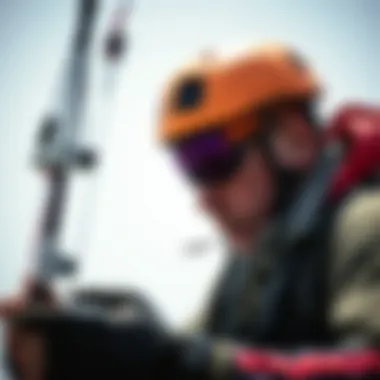
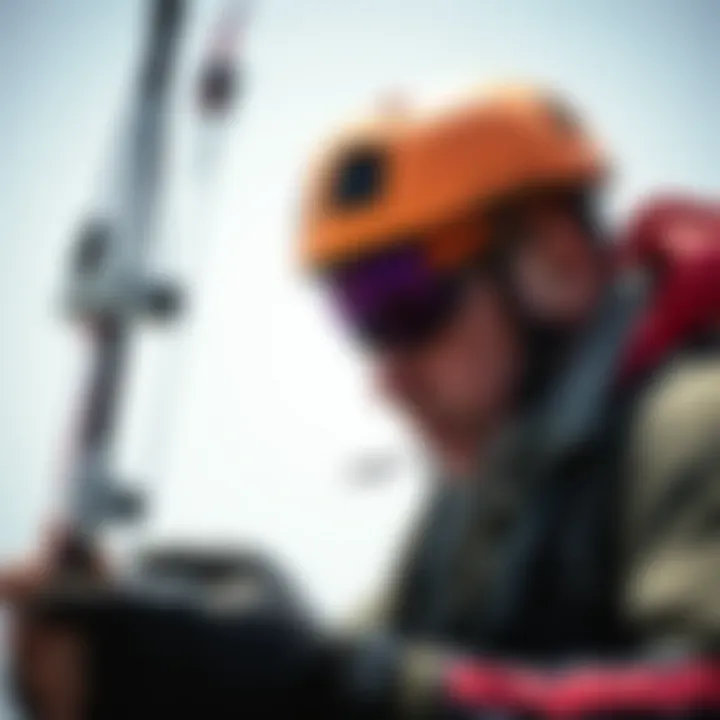
Moreover, end-of-season sales will often lead to a rise in used gear as sellers look to unload products before winter hits. Kiteboarders looking to upgrade might feel the urge to sell their older equipment, driving down prices across the board. In this sales climate, negotiation can be key. Sellers should be willing to part with their gear at reasonable prices to move inventory before it becomes outdated with the upcoming year’s trends.
In summary, recognizing these factors gives both buyers and sellers a significant edge. Individuals looking to enter the used kiteboarding gear market must pay close attention to prevailing trends and seasonal changes. Such awareness ensures they won’t be caught flat-footed when the winds shift.
Buying Used Kiteboarding Gear
Purchasing used gear is a key consideration for anyone interested in kiteboarding, whether you're just starting out or are a seasoned pro. It allows you to enter the sport without shelling out a fortune, thus making it more accessible to a wider audience. Also, there’s a certain thrill in finding that perfect piece of gear that fits both your style and budget. As we dive further into the world of pre-owned kiteboarding equipment, let's look at how to navigate this market effectively.
Identifying Reliable Sellers
Reputation and Reviews
When you're eyeing a piece of used equipment, the seller's reputation and the reviews they’ve garnered can speak volumes. A good seller usually has a history of satisfying previous customers. This aspect is not only about the stars on a review site; it's about listening to what other buyers are saying. Positive feedback can help you to steer clear of sellers who might not be upfront about the condition of their gear.
Moreover, checking multiple platforms for reviews provides a broader understanding of the seller's reliability, especially if they are using sites like Reddit or specialized kiteboarding forums. It’s critical to prioritize sellers who consistently receive high ratings. If you spot several negative reviews, consider that a potential red flag.
Seller Transparency
Transparency from the seller is another aspect that ties into your confidence in a purchase. Look for sellers who provide thorough descriptions of the gear they are selling—photos are a must, but so are details about usage and any repairs done. When a seller is clear about the condition and history of their item, it typically indicates trustworthiness. If they are evasive with questions, it’s often best to walk away. This transparency can save you from unpleasant surprises down the line, providing a smoother transaction experience.
Evaluating Equipment Condition
Key Areas to Inspect
Before sealing the deal on any used kiteboarding gear, focusing on key areas of the equipment is essential. Pay close attention to the kite’s canopy for wear and tear—this part takes the brunt of the forces when in use. Inspect the leading edges for punctures and abrasions and check the seams for any signs of fraying. Don’t forget to look at the lines and the control bar as well; these components are crucial for safety and performance. Getting a feel for the gear's condition through a detailed inspection can save you money in the long term by reducing your need for repairs.
Red Flags to Avoid
It’s also vital to be aware of red flags that could indicate a deal that’s too good to be true. For instance, if the price is significantly lower than similar items on the market, question why. There might be underlying issues that the seller isn’t revealing. Also, if the seller avoids providing detailed photos or seems impatient with your questions, that’s another cause for concern. Being vigilant can help you avoid purchasing equipment that will give you trouble later.
Negotiating Prices
Once you have identified what gear you want and deemed a seller reliable, it's time to discuss the price. Remember, negotiating doesn’t have to be awkward—it’s simply a part of the buying process in the used gear market. Be polite but firm; if you've done your homework, you’ll have a good idea of the item’s going rate, allowing you to negotiate based on condition and the seller’s history.
Purchasing from Online Marketplaces
Benefits of Online Shopping
Purchasing used kiteboarding gear online offers a wealth of options at your fingertips. You can browse various listings, compare prices, and find exactly what suits your needs without traveling from store to store. Plus, the ability to utilize filters to search by brand, condition, or price range makes it much easier to find exactly what you're looking for. Many platforms also provide customer protection measures that can make the buying process more secure.
Secure Transaction Practices
When buying online, secure transaction practices must be at the forefront of your mind. Avoid wire transfers when possible; they don't offer much recourse if something goes awry. Instead, look for platforms that offer protection for buyers and ensure the transaction is traceable. For instance, PayPal is a popular choice that offers buyer protection policies. Ensuring your transactions are safe provides peace of mind as you dive into purchasing used gear.
Always trust your instincts when it comes to the seller and the deal at hand. If something feels off, it probably is.
Selling Used Kiteboarding Gear
Selling used kiteboarding gear is a pivotal component of the kiteboarding landscape today. Not only does it help enthusiasts and professionals manage their gear investments effectively, but it also fosters a community of sharing and sustainability. Every kite, board, and harness holds a story. Each piece of equipment shared can steer new adventurers towards the thrill of the sport. When one sells their used gear, they step into a cycle that promotes growth, affordability, and environmental consciousness.
Preparing Equipment for Sale
Cleaning and Repairs
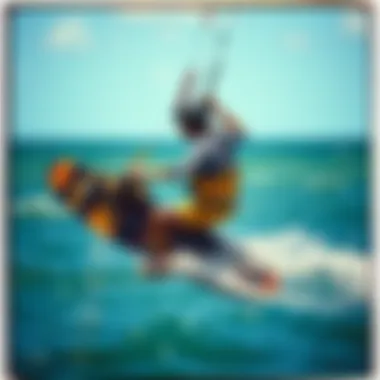
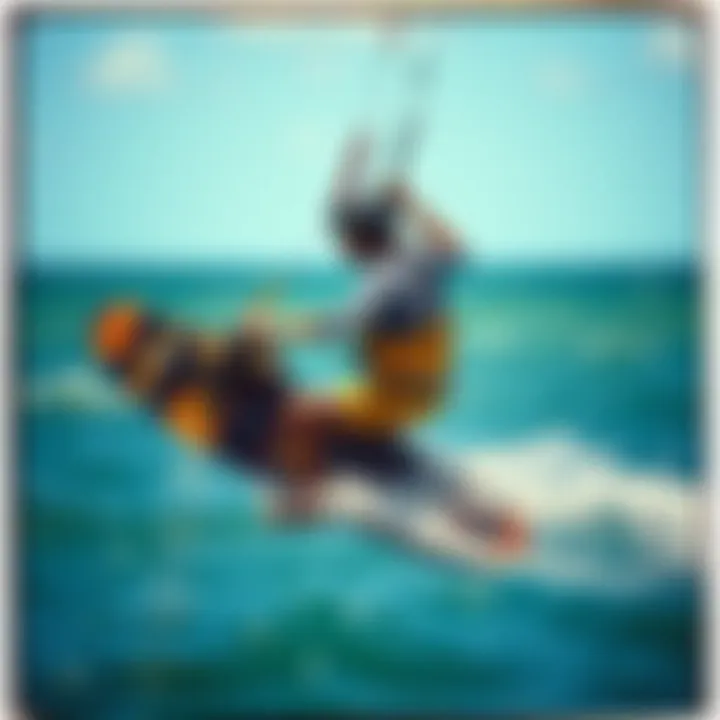
When it's time to sell used kiteboarding gear, the focus on cleaning and repairs becomes crucial. A well-maintained piece of equipment speaks volumes. Buyers are generally keen to know about the state of the gear they’re eyeing, and first impressions can make or break a sale. Proper cleaning isn’t just about aesthetics; it’s about safety and function.
- Washing kites regularly can prevent mildew and ensure the fabric remains intact.
- Inspecting for wear and tear, especially on the lines and lead straps, is essential for overall durability.
While it may take some extra elbow grease, the time invested in cleaning and minor repairs often pays off. Clean gear increases perceived value, encouraging buyers to see the worth in what might be seen merely as second-hand equipment.
Effective Descriptions
Effective descriptions play a starring role in selling used gear. When potential buyers scroll through listings, they search not only for visuals but also for narratives that speak to the quality and usage. Describing the specifics of the gear—age, model, and notable features—can help buyers make informed decisions.
- Clear descriptions help highlight unique characteristics, such as specific models or modifications.
- Transparency about usage history, like how often the gear was used and in what conditions, builds trust with potential customers.
Good descriptions can also facilitate negotiations, allowing the seller to justify their asking price based on item condition and performance history.
Advertising Strategies
Choosing the Right Platform
Selecting the right platform for your advertising strategy is paramount in reaching the right audience. Different platforms cater to varying demographics and interests, so strategizing on where to post can determine how quickly and effectively your gear sells. For instance, niche marketplaces specifically dedicated to outdoor sports often yield better results than general classifieds.
Additionally, platforms like KiteForum or specialized Facebook groups can attract a more focused audience, ready to buy.
- Consider visibility along with user engagement; platforms with high traffic and a strong community can help elevate your listing.
- Don’t underestimate the power of good old-fashioned word-of-mouth, too. Sharing your listing within local kiteboarding clubs can also yield promising leads.
Target Audience Considerations
Understanding your target audience is crucial in crafting your selling approach. Are you catering to a novice kiteboarder or an experienced rider? Tailoring your advertisements can better resonate with potential buyers, increasing the likelihood of a sale.
- Newer kiteboarders might appreciate insights on ease of use, safety features, or recommendations for complementary equipment.
- Conversely, experienced kiteboarders will look for technical specifications and performance metrics to gauge the gear's capability.
Adapting your tone and content can mean the difference between a casual browser and a committed buyer.
Transaction Best Practices
Navigating transactions with care is as vital as selling the gear itself. Safeguarding both parties involves clear communication, straightforward pricing, and preferred payment methods. Additionally, whether selling in person or online, keeping integrity and honesty at the forefront makes for a smooth and trustworthy transaction. In an environment where gear changes hands frequently, establishing a reputation for reliability can lead to repeat business and referrals, creating a cycle of success in the kiteboarding community.
Maintaining Used Kiteboarding Gear
In the realm of kiteboarding, ensuring the longevity and performance of your gear is crucial. Like any sporting equipment, used kiteboarding gear requires regular maintenance. This is not just about keeping the gear looking good; it’s about ensuring your equipment performs at its best when you hit the water. A well-maintained kite or board won’t just keep you safe, it can significantly enhance your overall riding experience. Therefore, understanding the importance of proper care can lead to smarter decisions in gear usage, potentially extending the lifespan of your equipment and saving you money in the long run.
Routine Care and Maintenance
Storage Tips
One of the most significant aspects of maintaining used kiteboarding gear is how you store it. Storing properly can prevent a host of problems. First, it’s best to keep your kites and boards in a cool, dry place, away from direct sunlight. Sunlight can degrade the fabric of your kite over time, resulting in a loss of performance. Additionally, make sure to roll rather than fold your kites; folds can lead to creases that compromise the integrity of the sail.
Using a padded bag for storage not only protects the surfaces from scratches but also cushions them from impacts. This prevents minor damages that could turn costly. In the world of kiteboarding, maintaining optimal conditions for your gear while in storage isn’t just a precaution; it’s a smart practice that can pay off when it matters most.
Repair Procedures
When it comes to repairs, understanding how to tackle common issues can save both time and money. Minor punctures or tears in your kites can be fixed easily with repair tape specifically designed for this purpose. Many kiteboarders also keep a basic repair kit with a couple of essential items such as a needle and thread for larger rips.
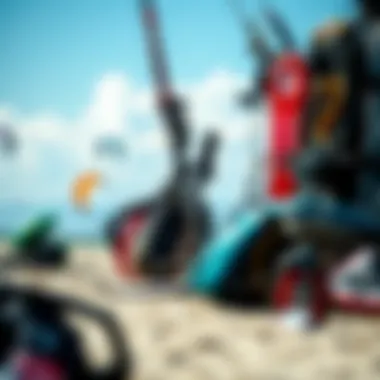
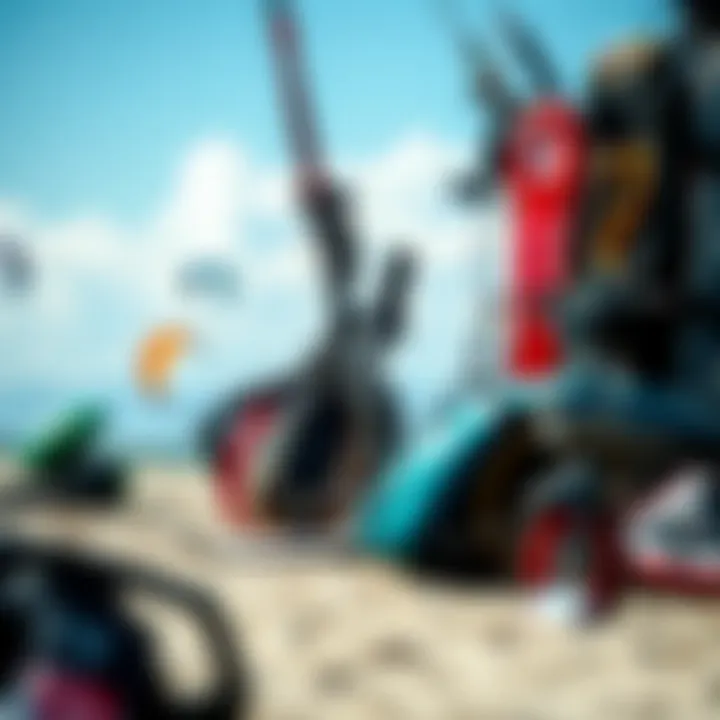
A key benefit of learning basic repair procedures is self-sufficiency. Knowing how to make small repairs can keep you out on the water instead of waiting for professional help. However, one should be cautious; not all damage can be fixed at home. If the structural component of your gear is at stake, it’s best to consult a professional to prevent further issues. Navigating these repair landscapes effectively can greatly enhance your experience with used kiteboarding gear.
Signs of Wear and When to Replace
It's crucial to be vigilant about spotting signs of wear on your equipment. For instance, frayed lines, a discolored canopy, or a board with noticeable dings can all indicate that a replacement might be on the horizon. Regular check-ups before and after each session can help in assessing the gear’s condition. More importantly, knowing when to replace rather than repair is key. Riding on compromised equipment not only jeopardizes your safety but can also hinder your performance.
In short, maintaining used kiteboarding gear requires a blend of routine care, thoughtful storage, and timely repairs. Embracing these aspects not only protects your investment but ensures you’ll spend more time riding the waves and less time worrying about your equipment.
Upgrading Used Kiteboarding Equipment
Upgrading used kiteboarding equipment can be a game changer for any enthusiast looking to elevate their experience on the water. The world of kiteboarding is evolving rapidly, with technological advancements consistently reshaping the way gear performs. Upgrading involves not just replacing old components but understanding what new options are out there and how they can fit into one's existing set-up. This process is particularly significant for those seeking improved performance, safety, and overall enjoyment while riding through the waves.
Understanding Modern Advancements
As kiteboarding technology continues to evolve, several breakthroughs offer practical benefits to riders. For instance, newer kite materials can provide better durability and lighter weight, enhancing maneuverability. Additionally, the design of kite shapes has seen considerable advancement, optimizing lift and reducing drag. The use of tech like strutless kites, which offer freedom of movement, exemplifies how simple changes can enhance one's riding performance.
Furthermore, bar and line systems have become more refined, incorporating features such as improved safety release mechanisms and higher durability lines, which contribute to a more reliable and enjoyable ride.
- Modern Materials:
- Kite Designs:
- Lighter fabrics that resist tearing and wear.
- Improved waterproof coatings that keep gear lightweight and functional.
- Increased shape variety for different wind conditions and styles.
- Innovative designs that enhance jumping capabilities and stability.
Understanding these advancements allows kiteboarders to pinpoint what features resonate with their specific riding style. For instance, a person who enjoys freestyle might prioritize advanced kite shapes, while a wave rider may benefit from the enhanced stability of a different kite type. Evaluating each new development provides an essential foundation for making informed upgrade decisions.
Selecting Compatible Upgrades
When considering upgrades, compatibility with existing equipment is crucial. This doesn’t mean blindly purchasing the latest model but requires some thought and research.
- Assess Current Setup: Before diving into new gear, take stock of what's currently being used. Identifying strengths and weaknesses in your current kite, board, and lines helps in aligning upgrades effectively.
- Synergy of Components: Ensure any new additions function harmoniously with existing gear. For instance, if upgrading to a newer kite, make sure the lines are compatible in terms of length and strength.
- Focus on Significant Enhancements: Some riders may upgrade every season, while others may opt for focused enhancements every few years. Prioritize upgrades that promise noticeable performance improvements. For instance, if the current board feels cumbersome, a sleeker design could vastly improve the ride.
- Consult Community Experts: Online forums and social media groups can be great resources. Other riders can offer insight into what upgrades worked best for them based on real experiences. Platforms like Reddit and kiteboarding-specific Facebook groups can be key places to gather firsthand opinions and recommendations.
Ultimately, thoughtfully selecting compatible upgrades can lead to improvements that enhance both safety and enjoyment, allowing kiteboarders to maximize their experience on the water.
"The right equipment can be the difference between a thrilling ride and one filled with frustration—choose wisely!"
The Future of Used Kiteboarding Gear
The future of the market for used kiteboarding gear represents a dynamic intersection of innovation, demand, and environmental consciousness. This section reflects on the trends that are shaping this market and the driving forces behind them. In an era where sustainability increasingly takes center stage, second-hand gear not only highlights the virtues of recycling but also opens doors to a wider range of enthusiasts who might have previously found the sport financially inaccessible. As new technologies evolve, they have the potential to enhance the functionality and accessibility of used gear, inviting a new wave of interest from both novices and seasoned kiteboarders.
Emerging Technologies
Used kiteboarding gear is benefitting from rapid advancements in technology, which continually redefine standards of performance and durability. Kiteboarding equipment designed with cutting-edge materials such as Dyneema for lines and ripstop nylon for kites can withstand more wear, thus making second-hand options more appealing. Additionally, manufacturers are implementing more eco-friendly production processes, which leads to second-hand items that have fewer environmental footprints.
With ongoing research into materials like lightweight carbon composites, the lifespan of used equipment significantly extends, allowing these items to maintain their value over time. This dynamic leads to a more robust second-hand market as kiteboarders feel more confident purchasing equipment that is not only economically viable but also technologically advanced.
In the future, digital platforms that utilize augmented reality may become prevalent, enabling buyers to get a more hands-on feel of equipment even before meeting the seller. Imagine being able to virtually test out a kite or board through your smartphone before making a purchase! This intersection of technology and commerce stands to revolutionize how enthusiasts interact with used gear, possibly expanding the global reach for sellers willing to leverage such innovations.
Market Projections
The projections for the used kiteboarding gear market are indeed promising. Analysts note a rising trend in outdoor activities like kiteboarding, particularly among younger demographics who are acutely aware of budget constraints and environmental issues. As kiteboarding's popularity burgeons, so too does the appetite for second-hand gear, anticipated to grow by an estimated 15% annually over the next five years. This growth is shaped not only by economic factors but also by an increasing shift in mindset; more people are looking into sustainability as a core value in their consumer choices.
Given that kiteboarding is an adventure sport, many kiteboarders often upgrade their gear with new tech to enhance performance. This notion of upgrading will keep the cycle of quality second-hand gear circulating within the community.
Thus, engaging in the used gear market might soon be perceived as the norm rather than the exception, with platforms emerging that cater specifically to this audience.
"Buying used gear is not just about saving money; it's about being part of a community that's conscious of its footprint while still enjoying the thrill of kiteboarding."
With the convergence of technical advancements and a conscientious consumer base, the landscape for used kiteboarding gear is in for significant transformation, promising sustainable, economically sound, and performance-driven choices for years to come.







